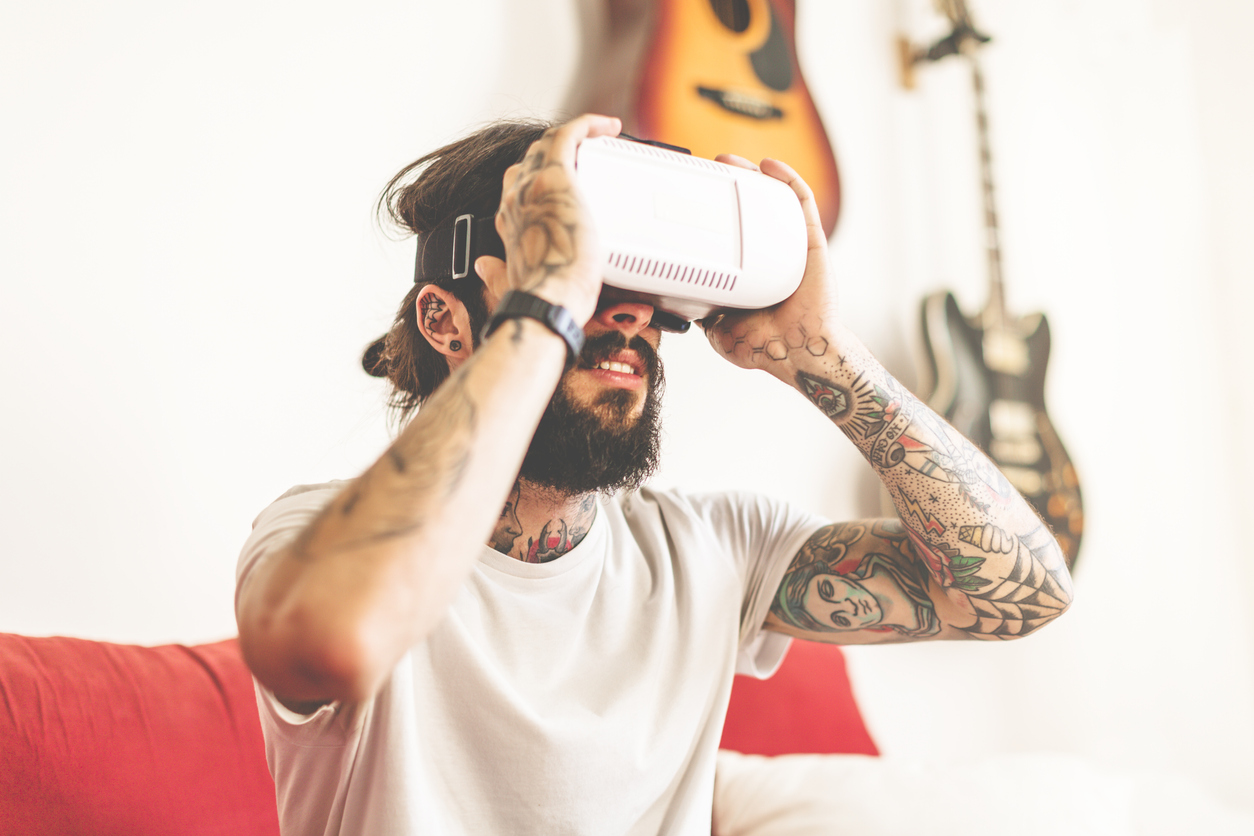Unless you’ve been in hiding without a smartphone, you’ve heard a lot about virtual reality. For some, VR is touted as the “it” technology that will save marketing (or make it cool again). From the Consumer Electronics Show in Las Vegas to gamer and entertainment blogs, it’s been hot water-cooler talk for some time. If you’ve experienced virtual reality yourself, you have to admit it’s pretty cool tech. But is it really the next big thing, or will it just be another arrow in the marketing quiver? Will it distract advertisers and consumers from real reality? With increasing pressure on marketing budgets and expectations for ROI, should you make room in your marketing budget and strategy for leading-edge tech tactics?
The Two Faces of VR
There are really two ways to look at virtual reality. Its originators saw VR as anything that lets you interface with an artificial digital world (think first-person shooter video games). Then there’s the new and improved definition: a three-dimensional, computer-generated environment that can be explored and manipulated by a person.(1) That newer definition, supported by gobs of great PR for devices such as Oculus Rift and other head-mounted display (HMD) wearables, is what has people so worked up.
So what is an HMD device, and what makes it different? Even if you haven’t experienced it for yourself, you’ve seen news segments or YouTube videos by now and know that, essentially, it’s a computer screen you wear over your eyes. More importantly, VR HMDs let you use your hands to manipulate or interact with the virtual world you’re experiencing. The ability to throttle a zombie or browse the jewelry displays at Tiffany & Co. creates an attraction for marketers. Imagine whole new worlds (or stores) where brands can create the environment and own the end-to-end customer experience unimpeded. As a medium, that sounds pretty sexy, right?
But what really makes a good advertising medium in today’s market? To be a viable marketing tool, a medium needs a few essential qualities:
- Targetability: The ability to reach a targeted audience with your message
- Measurability: Some form of accepted metric that allows you to compare the effectiveness and efficiency of one medium over another
- Scalability: As a function of measurability and efficiency, a good medium will be able to reach the largest number of target consumers across the largest geography at the lowest possible cost
New Tech Troubles
Like all good ideas, great new technologies run into snags. For example, in the early 2000s, I helped create a digital, place-based advertising network in bars using bar-top video games and jukeboxes. We were in love with the idea because it had incredible targetability. We could deliver relevant messaging to twentysomethings who hung out in herds at bars. The opportunities were myriad: spirit and beer companies with their deep-pocket advertising in the on-premise channel, energy drinks, music, movies, late-night fast food…the list was substantial. So, targetability, check.
Then came measurability. As a member of the board of directors at the Out-of-Home Advertising Bureau (now the Digital Place-Based Advertising Association), I can attest to the fact that we were torn. One very large faction of networks (the ones that also owned lots of billboards) wanted to treat place-based video like out-of-home, with an eyes-on approach. Another network faction wanted to work with Nielsen to develop TV-like ratings systems that were reliable, and yet another faction wanted to track the ads in a fashion similar to digital video and banner ads—with click-through and engagement metrics. Who was right? Well, everyone, of course. These ads were “served” like digital media, but many were static like outdoor and TV. The absence of a common metric for measurability caused confusion with media agencies. While place-based video did grow, we found that it grew from a very small base of toe-dippers, and rarely had return customers.
That was all before we arrived at scalability. The lack of common function, unit sizes, unit lengths, levels of interactivity and the ability to do apples-to-apples measurement, combined with the spottiness of geographic coverage of the individual networks, made media buyers and planners want to pull their hair out.
While place-based networks continue to work out those issues, or function as hyper-targeted niche tactics, it’s worth considering the lesson when discussing VR.
New Tech Fail
A more severe example of how new tech can go quickly awry is the great 3D bonanza of 2012. ALL the buzz at the Consumer Electronic Show that year was about 3D TV being the next big thing in entertainment, and advertisers who wanted to be first to the party rushed headlong into creating ads for the coming 3D revolution. Yet by the 2013 CES, Extremetech.com was announcing that 3D TV was dead. The cause? Scale.
The cost of 3D tech was as much as double the cost of new high-definition TV (HDTV), and 3D lacked engaging content from TV providers while bringing little value to the entertainment experience. The latter two rendered 3D TV a poor investment for houses that bought their first 1080p screens only a few years before. As of this year, most major TV manufacturers have eliminated 3D compatibility from their sets.
The Perfect Situation
Conversely, there remain great examples of new technology completely changing the entertainment landscape, and in doing so, the very nature of marketing.
Digital (desktop/mobile/tablet) advertising works as a category because first, there is a general commonality of function in the devices. You can click an ad, watch a video, etc., whether you’re on an Android or iOS phone/tablet and regardless of your preference for Mac or PC. That creates a general uniformity of measurability. Second, because of the highly technical capabilities available to behaviorally target (and the billions of data points captured by brands) digital provides marketers with the best possible ability to target and hypertarget consumers. And third, because the combination of computers, tablets and phones make the digital platform nearly ubiquitous – Pew Research Center says that about 85 percent of Americans use the internet—you’ve got scale.(2)
So, where does that leave virtual reality today and in the near future? It’s uncertain. A March 2016 survey by Morning Consult cited in the Forbes magazine article “Virtual Reality Awareness Is High, But Will They Buy?”(3) says that while there is very high interest in “trying out a VR device” (71 percent), 54 percent of respondents had no interest in actually ever buying one, while only 6 percent said they planned to buy one in the next six months (10 percent in the next one to two years). Compared with other media, that type of penetration limits scale considerably.
Then there’s the question of content. According to Forbes, the sweet spot for people planning to buy a VR HMD are young—under 29—and the majority of content being developed for VR is gaming-related. That makes sense (after all, our first foray into serious VR content was gaming), but most media thrive on an abundance of content types to deliver both scale and targetability.
To be a successful medium with scale and broad targetability, VR will have to overcome that challenge and get beyond games and cool gimmicky experiences to add long-term meaningful value to consumer’s daily lives. Today, it’s not clear whether virtual reality will follow the slow and steady path of place-based video, the crash-and-burn life of 3D TV or truly be the next great thing that transforms the digital landscape. To be sure, there are some very powerful companies investing in VR, including Sony, Apple, Google and Facebook, so there is a lot of optimism out there that VR will be a significant part of our lives, eventually. Without common agreement on how to serve and measure marketing content through the growing and disparate army of VR devices, brands need to consider the real reality that investing scarce marketing dollars in the tech now may not deliver the return they want.


